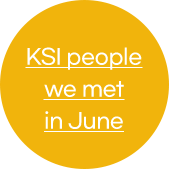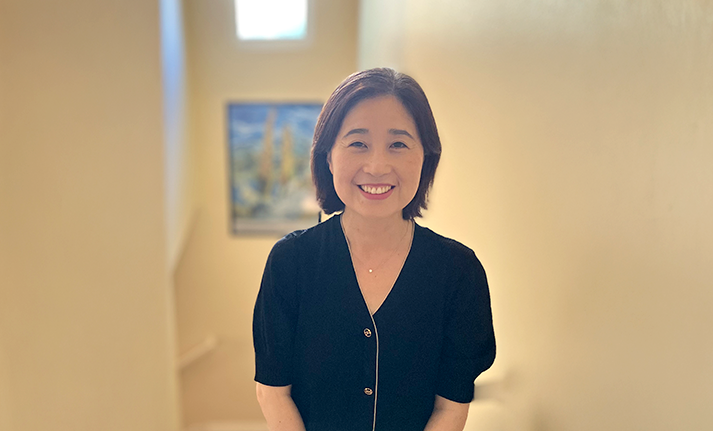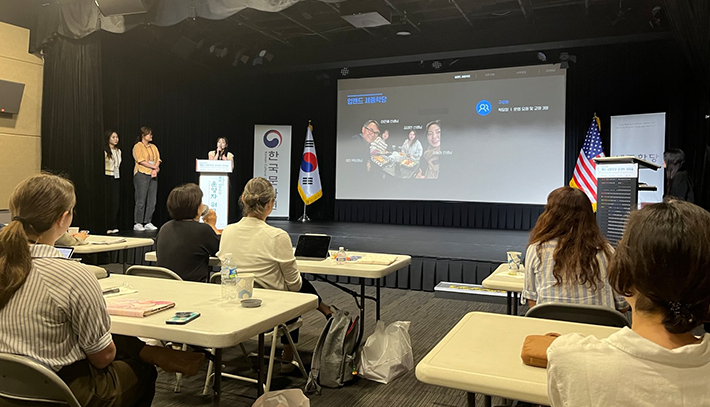

“I hope learning Korean will enrich the lives
of our learners.”
A Conversation with Teacher Yang Yun-seon,
Participant of the 2025 KSI Workshop
in North America
Yang Yun-seon, a teacher who has been teaching Korean for seven years at the KSI Center, U.S.A., participated in
the 2025 KSI Workshop in North America held from June 11 to 13. The workshop provided a meaningful opportunity
to reflect on the roles and future direction of KSIs in the North American region. In this interview, she shares
her impressions of the workshop, her thoughts on the value of Korean language education gained through working
with learners from diverse cultural backgrounds, and her personal beliefs and goals as a teacher.
Hello, Teacher Yang Yun-seon! It’s a pleasure to meet you. To start, could you please introduce yourself
briefly to the readers of Monthly Knock Knock and tell us about the KSI you’re currently involved with?
Hello! My name is Yang Yun-seon, and I teach Korean at the KSI Center, U.S.A. Located in Los Angeles, the KSI
Center, U.S.A. was established in 2018 as a regional center supporting KSIs across North America. Currently,
five local teachers conduct classes at the center.
At the KSI Center, U.S.A., our learners come from a wide range of ages and backgrounds—from college students who
are huge fans of K-pop and take classes with their mothers, to retirees who study Korean as a hobby. Thanks to
its location near Hollywood and the largest Koreatown in the U.S.A., we also see many students who work in the
film and drama industries, as well as learners from the Korean diaspora. In addition, many students are
motivated to study Korean in order to better understand Korean dramas and K-pop.
How long have you been teaching Korean at the KSI Center, U.S.A.? What led you to start teaching Korean
locally, and how has that experience influenced you as a teacher?
I’ve been teaching Korean at the KSI Center, U.S.A. since it first opened in 2018—so it's been nearly seven
years now. I majored in Korean at university, and after immigrating to the U.S.A., I naturally found myself
teaching the language. I started out teaching Korean to teenagers at weekend schools and academies, and now I
teach at both the KSI Center, U.S.A. and San Diego State University.
Most of the learners at the KSI Center, U.S.A. study Korean because they genuinely enjoy the language and love
Korean culture, which creates a fun and engaging classroom atmosphere. As I work to be a good guide for these
eager learners—who light up with curiosity during class—I find myself growing alongside them. The time I spend
with my students is a positive source of motivation in my life.
Learners attending classes at the KSI Center, U.S.A.
You participated in the 2025 KSI Workshop in North America, held from June 11 to 13. Was there a particular
moment during the workshop that stood out to you the most?
The 2025 KSI Workshop in North America was brief but incredibly enriching. In particular, the special lectures
on the second day gave me a chance to reflect on the content and objectives of my classes as a Korean language
teacher. The lecture on “K-Content and Korean Language Education” offered a fresh perspective on how to approach
content, while the session on “The Role and Direction of KSIs in North America” prompted me to consider how to
design lessons that accommodate a diverse range of learners.
But what left the strongest impression on me were the presentations each KSI had prepared, sharing their
operational status and classroom practices. Until now, there had been few opportunities to learn about how other
KSIs—especially those located far away—run their classes. Through this workshop, I was able to gain insights
into their achievements, outstanding teaching examples, and challenges. It allowed me to reflect both on the
unique characteristics of the North American context and on the future direction of KSIs as a whole. I also
vividly remember how teachers from other states were so impressed by the Korean food they got to enjoy at every
meal in Los Angeles.
 Workshop participants listening to a presentation on the operational status
Workshop participants listening to a presentation on the operational status
and classroom practices of KSI Upland, U.S.A.
This year’s workshop included a “Korean Culture Teaching Methods and Practicum” program specifically for
Korean language teachers. Were there any new teaching methods or classroom ideas you learned during the
workshop that you’d like to share?
The “Korean Culture Teaching Methods and Practicum” program was conducted as a hands-on class using traditional
Korean bojagi (wrapping cloths). During the practicum, teachers exchanged ideas on how this activity could be
applied in classrooms across the U.S.A. and Canada. It was particularly useful for planning lessons geared
toward American learners who are interested in gift wrapping.
In addition, during the lecture on “The Role and Direction of KSIs in North America,” I learned about backward
design, a teaching method that begins by focusing on what learners will ultimately do, and then working
backwards to plan the instruction. I found this learner-centered approach—especially its alignment with local
language standards in the U.S.A.—to be a valuable model that could be applied in our classrooms.
Korean language teachers participating in a cultural class using traditional Korean bojagi as part of the
“Korean Culture Teaching Methods and Practicum” program
Finally, could you share the goals you hope to achieve at the KSI Center, U.S.A.? We’d also love to hear about
your personal goals as a Korean language teacher.
I believe that learning a new language is not just about acquiring vocabulary and grammar—it’s about
encountering a new culture and expanding one’s worldview. I hope that the learners I meet at KSI will experience
a richer, more meaningful life as they learn Korean and engage with Korean culture. I want to serve as a small
bridge on that journey. I also aspire to be a teacher who grows alongside my students.hat journey. I also aspire
to be a teacher who grows alongside my students.